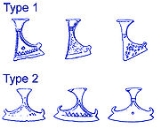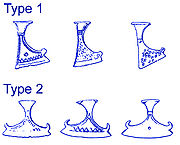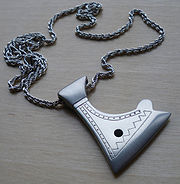
Axe of Perun
Encyclopedia
The Axe of Perun was the axe wielded by the Slavic god of thunder and lightning, Perun
.
Similar to Thor's hammer, miniature amulets were worn by the Pre-Christian Slavs as pendants honouring their God.

 The axes range in length from 4 to 5.5 cm, and blade width from 2.8 to 4 cm. Bronze is the most common material of their construction. Most have been dated between the 11th and 12th century, and over 60 specimens have been collected.
The axes range in length from 4 to 5.5 cm, and blade width from 2.8 to 4 cm. Bronze is the most common material of their construction. Most have been dated between the 11th and 12th century, and over 60 specimens have been collected.
Two basic designs of the axe have been found throughout Russia and its boundaries.
Specimens of both designs include a hole in the centre of the blade, and both have been decorated with zigzag lines, representing lightning, near the edge of the blade.
Type 1:
The first type is a bearded axe
(lower side of the blade is elongated) with a flat upper side. It resembles a battle axe. A knob-like protrusion is usually present on the lower side of the axe. These axes have been decorated with circles, believed to represent celestial bodies.
Type 2:
The second type is distinguished by its symmetrical shape and broad blade. Similar to the knob of the first type, the second has two horn-like protrusions diametrically opposite on the upper and lower side.
Perun
In Slavic mythology, Perun is the highest god of the pantheon and the god of thunder and lightning. His other attributes were the fire, mountains, the oak, iris, eagle, firmament , horses and carts, weapons and war...
.
Similar to Thor's hammer, miniature amulets were worn by the Pre-Christian Slavs as pendants honouring their God.
Amulet Description


Two basic designs of the axe have been found throughout Russia and its boundaries.
Specimens of both designs include a hole in the centre of the blade, and both have been decorated with zigzag lines, representing lightning, near the edge of the blade.
Type 1:
The first type is a bearded axe
Long-bearded axe
A bearded axe, or Skeggöx refers to various axes, used as a tool and weapon, as early as the 6th century AD. It is most commonly associated with Viking Age Scandinavians...
(lower side of the blade is elongated) with a flat upper side. It resembles a battle axe. A knob-like protrusion is usually present on the lower side of the axe. These axes have been decorated with circles, believed to represent celestial bodies.
Type 2:
The second type is distinguished by its symmetrical shape and broad blade. Similar to the knob of the first type, the second has two horn-like protrusions diametrically opposite on the upper and lower side.

